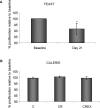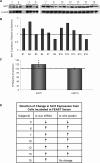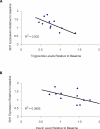In vitro cellular adaptations of indicators of longevity in response to treatment with serum collected from humans on calorie restricted diets
- PMID: 18791640
- PMCID: PMC2527659
- DOI: 10.1371/journal.pone.0003211
In vitro cellular adaptations of indicators of longevity in response to treatment with serum collected from humans on calorie restricted diets
Abstract
Calorie restriction (CR) produces several health benefits and increases lifespan in many species. Studies suggest that alternate-day fasting (ADF) and exercise can also provide these benefits. Whether CR results in lifespan extension in humans is not known and a direct investigation is not feasible. However, phenotypes observed in CR animals when compared to ad libitum fed (AL) animals, including increased stress resistance and changes in protein expression, can be simulated in cells cultured with media supplemented with blood serum from CR and AL animals. Two pilot studies were undertaken to examine the effects of ADF and CR on indicators of health and longevity in humans. In this study, we used sera collected from those studies to culture human hepatoma cells and assessed the effects on growth, stress resistance and gene expression. Cells cultured in serum collected at the end of the dieting period were compared to cells cultured in serum collected at baseline (before the dieting period). Cells cultured in serum from ADF participants, showed a 20% increase in Sirt1 protein which correlated with reduced triglyceride levels. ADF serum also induced a 9% decrease in proliferation and a 25% increase in heat resistance. Cells cultured in serum from CR participants induced an increase in Sirt1 protein levels by 17% and a 30% increase in PGC-1alpha mRNA levels. This first in vitro study utilizing human serum to examine effects on markers of health and longevity in cultured cells resulted in increased stress resistance and an up-regulation of genes proposed to be indicators of increased longevity. The use of this in vitro technique may be helpful for predicting the potential of CR, ADF and other dietary manipulations to affect markers of longevity in humans.
Conflict of interest statement
Figures






References
-
- Austad SN. Life extension by dietary restriction in the bowl and doily spider, Frontinella pyramitela. Exp Gerontol. 1989;24:83–92. - PubMed
-
- Lin SJ, Defossez PA, Guarente L. Requirement of NAD and SIR2 for life-span extension by calorie restriction in Saccharomyces cerevisiae. Science. 2000;289:2126–2128. - PubMed
-
- Masoro EJ. Dietary restriction: current status. Aging (Milano) 2001;13:261–262. - PubMed
Publication types
MeSH terms
Substances
Grants and funding
LinkOut - more resources
Full Text Sources
Research Materials

